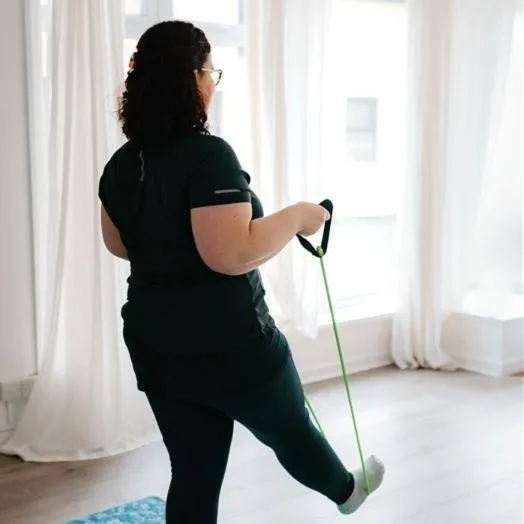


BLOG
Step into Your Power. Learn, Transform, Thrive in Life Transitions. Embrace Your Best Self.

How to Build a Sustainable Movement Habit That Supports Your Health
How to Build a Sustainable Movement Habit That Supports Your Health
Movement isn’t just about fitness goals or gym memberships — it’s one of the most powerful tools we have for supporting women’s health across every stage of life.
Whether you’re navigating perimenopause, recovering from birth, managing chronic fatigue, or simply trying to age well, consistent movement plays a vital role in everything from hormonal balance and mental health to joint support and long-term disease prevention.
But building a sustainable habit — one that works with your energy, your pain levels, your lifestyle — can feel overwhelming. Especially if you’re already tired, injured, or unsure where to start.
In this blog, I’m sharing the key benefits of movement for women’s health, the common barriers that hold us back, and realistic ways to make movement a consistent part of your daily life.

Why Movement Matters for Women
Movement isn’t just about burning calories or toning up. For women, especially in midlife and beyond, regular movement supports:
Hormonal balance — helping with hot flushes, night sweats, and mood changes
Joint and muscle health — reducing stiffness and pain, especially during menopause
Heart and bone health — lowering the risk of cardiovascular disease and osteoporosis
Mental health and sleep — regulating stress hormones, supporting neurotransmitters, and improving sleep quality
Digestion and metabolism — aiding gut motility, blood sugar balance, and energy levels
Pelvic floor health — especially when integrated with Pilates or targeted physiotherapy
The right kind of movement can also help with weight management, injury prevention, and overall resilience — not just now, but as you age.

Common Barriers to Staying Active
If you struggle to stay active, you’re not alone. These are some of the most common reasons women tell me they find movement difficult:
Fatigue or low energy — especially common in perimenopause or chronic conditions like CFS
Pain or injury — leading to fear of making things worse
Lack of time — busy lives, caring roles, and work stress make scheduled workouts unrealistic
Fear or uncertainty — not knowing what’s safe, effective, or where to begin
Low motivation — especially when symptoms are flaring or results feel slow
The good news? You don’t have to push through or ignore these challenges. With the right support, you can work with your body — not against it.
5 Practical Ways to Build a Movement Habit That Sticks
Start small.
If you’re doing nothing now, don’t aim for five workouts a week. Begin with two short walks or 10 minutes of stretching — and build from there.
Link it to something you already do.
Try stretching while the kettle boils, walking during a podcast, or balancing while brushing your teeth. Tiny habits add up.Make it enjoyable.
Hate the gym? Don’t go. Love music? Dance in the kitchen. Movement should feel good — not like punishment.Focus on progress, not perfection.
A 5-minute stretch is better than nothing. One Pilates class is better than an ideal routine you never stick to. You don’t have to do it perfectly — just consistently.Get support.
If you’re unsure where to start, struggling with pain or fatigue, or feeling stuck — a Women’s Health Physio can help you move safely and confidently.
When to Seek Help
If movement feels difficult because of pelvic pain, joint issues, prolapse, menopause symptoms, or chronic fatigue — support is available. You don’t need to “just live with it” or figure it out alone.
At Thrive and Shine Women’s Wellness, I offer physiotherapy, Pilates, and menopause or postnatal MOTs tailored to your body, your life, and your goals.
Ready to Move with Confidence?
Whether you're managing joint pain, fatigue, menopause symptoms, or recovering postnatally, movement can be tailored to work with your body — not against it.
👉 Explore Women’s Health Physiotherapy for personalised support with pain, pelvic health, and movement.
💬 Or choose a focused check-in:

Sign up for our newsletter.
BLOG
Step into Your Power.
Learn, Transform, Thrive in Life Transitions.
Embrace Your Best Self.

How to Build a Sustainable Movement Habit That Supports Your Health
How to Build a Sustainable Movement Habit That Supports Your Health
Movement isn’t just about fitness goals or gym memberships — it’s one of the most powerful tools we have for supporting women’s health across every stage of life.
Whether you’re navigating perimenopause, recovering from birth, managing chronic fatigue, or simply trying to age well, consistent movement plays a vital role in everything from hormonal balance and mental health to joint support and long-term disease prevention.
But building a sustainable habit — one that works with your energy, your pain levels, your lifestyle — can feel overwhelming. Especially if you’re already tired, injured, or unsure where to start.
In this blog, I’m sharing the key benefits of movement for women’s health, the common barriers that hold us back, and realistic ways to make movement a consistent part of your daily life.

Why Movement Matters for Women
Movement isn’t just about burning calories or toning up. For women, especially in midlife and beyond, regular movement supports:
Hormonal balance — helping with hot flushes, night sweats, and mood changes
Joint and muscle health — reducing stiffness and pain, especially during menopause
Heart and bone health — lowering the risk of cardiovascular disease and osteoporosis
Mental health and sleep — regulating stress hormones, supporting neurotransmitters, and improving sleep quality
Digestion and metabolism — aiding gut motility, blood sugar balance, and energy levels
Pelvic floor health — especially when integrated with Pilates or targeted physiotherapy
The right kind of movement can also help with weight management, injury prevention, and overall resilience — not just now, but as you age.

Common Barriers to Staying Active
If you struggle to stay active, you’re not alone. These are some of the most common reasons women tell me they find movement difficult:
Fatigue or low energy — especially common in perimenopause or chronic conditions like CFS
Pain or injury — leading to fear of making things worse
Lack of time — busy lives, caring roles, and work stress make scheduled workouts unrealistic
Fear or uncertainty — not knowing what’s safe, effective, or where to begin
Low motivation — especially when symptoms are flaring or results feel slow
The good news? You don’t have to push through or ignore these challenges. With the right support, you can work with your body — not against it.
5 Practical Ways to Build a Movement Habit That Sticks
Start small.
If you’re doing nothing now, don’t aim for five workouts a week. Begin with two short walks or 10 minutes of stretching — and build from there.
Link it to something you already do.
Try stretching while the kettle boils, walking during a podcast, or balancing while brushing your teeth. Tiny habits add up.Make it enjoyable.
Hate the gym? Don’t go. Love music? Dance in the kitchen. Movement should feel good — not like punishment.Focus on progress, not perfection.
A 5-minute stretch is better than nothing. One Pilates class is better than an ideal routine you never stick to. You don’t have to do it perfectly — just consistently.Get support.
If you’re unsure where to start, struggling with pain or fatigue, or feeling stuck — a Women’s Health Physio can help you move safely and confidently.
When to Seek Help
If movement feels difficult because of pelvic pain, joint issues, prolapse, menopause symptoms, or chronic fatigue — support is available. You don’t need to “just live with it” or figure it out alone.
At Thrive and Shine Women’s Wellness, I offer physiotherapy, Pilates, and menopause or postnatal MOTs tailored to your body, your life, and your goals.
Ready to Move with Confidence?
Whether you're managing joint pain, fatigue, menopause symptoms, or recovering postnatally, movement can be tailored to work with your body — not against it.
👉 Explore Women’s Health Physiotherapy for personalised support with pain, pelvic health, and movement.
💬 Or choose a focused check-in:

Sign up for our newsletter.



